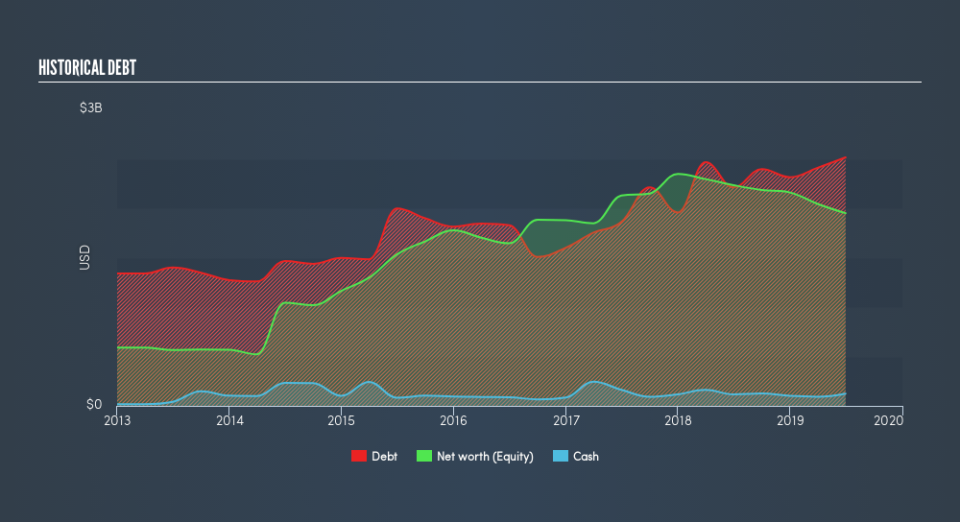Health Check: How Prudently Does Pattern Energy Group (NASDAQ:PEGI) Use Debt?

David Iben put it well when he said, 'Volatility is not a risk we care about. What we care about is avoiding the permanent loss of capital.' So it might be obvious that you need to consider debt, when you think about how risky any given stock is, because too much debt can sink a company. Importantly, Pattern Energy Group Inc. (NASDAQ:PEGI) does carry debt. But the more important question is: how much risk is that debt creating?
When Is Debt A Problem?
Debt is a tool to help businesses grow, but if a business is incapable of paying off its lenders, then it exists at their mercy. Part and parcel of capitalism is the process of 'creative destruction' where failed businesses are mercilessly liquidated by their bankers. However, a more common (but still painful) scenario is that it has to raise new equity capital at a low price, thus permanently diluting shareholders. By replacing dilution, though, debt can be an extremely good tool for businesses that need capital to invest in growth at high rates of return. When we examine debt levels, we first consider both cash and debt levels, together.
Check out our latest analysis for Pattern Energy Group
How Much Debt Does Pattern Energy Group Carry?
The image below, which you can click on for greater detail, shows that at June 2019 Pattern Energy Group had debt of US$2.51b, up from US$2.21b in one year. However, it also had US$124.0m in cash, and so its net debt is US$2.39b.
How Strong Is Pattern Energy Group's Balance Sheet?
We can see from the most recent balance sheet that Pattern Energy Group had liabilities of US$672.0m falling due within a year, and liabilities of US$2.75b due beyond that. On the other hand, it had cash of US$124.0m and US$87.0m worth of receivables due within a year. So it has liabilities totalling US$3.21b more than its cash and near-term receivables, combined.
Given this deficit is actually higher than the company's market capitalization of US$2.54b, we think shareholders really should watch Pattern Energy Group's debt levels, like a parent watching their child ride a bike for the first time. Hypothetically, extremely heavy dilution would be required if the company were forced to pay down its liabilities by raising capital at the current share price. There's no doubt that we learn most about debt from the balance sheet. But it is future earnings, more than anything, that will determine Pattern Energy Group's ability to maintain a healthy balance sheet going forward. So if you want to see what the professionals think, you might find this free report on analyst profit forecasts to be interesting.
Over 12 months, Pattern Energy Group reported revenue of US$496m, which is a gain of 9.3%. We usually like to see faster growth from unprofitable companies, but each to their own.
Caveat Emptor
Over the last twelve months Pattern Energy Group produced an earnings before interest and tax (EBIT) loss. Indeed, it lost US$12m at the EBIT level. Considering that alongside the liabilities mentioned above make us nervous about the company. We'd want to see some strong near-term improvements before getting too interested in the stock. It's fair to say the loss of-US$64.0m didn't encourage us either; we'd like to see a profit. In the meantime, we consider the stock to be risky. For riskier companies like Pattern Energy Group I always like to keep an eye on the long term profit and revenue trends. Fortunately, you can click to see our interactive graph of its profit, revenue, and operating cashflow.
If you're interested in investing in businesses that can grow profits without the burden of debt, then check out this free list of growing businesses that have net cash on the balance sheet.
We aim to bring you long-term focused research analysis driven by fundamental data. Note that our analysis may not factor in the latest price-sensitive company announcements or qualitative material.
If you spot an error that warrants correction, please contact the editor at editorial-team@simplywallst.com. This article by Simply Wall St is general in nature. It does not constitute a recommendation to buy or sell any stock, and does not take account of your objectives, or your financial situation. Simply Wall St has no position in the stocks mentioned. Thank you for reading.


